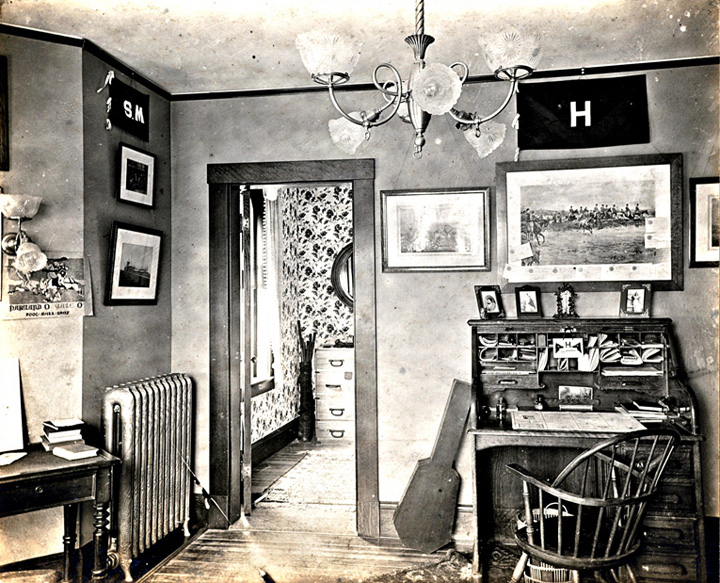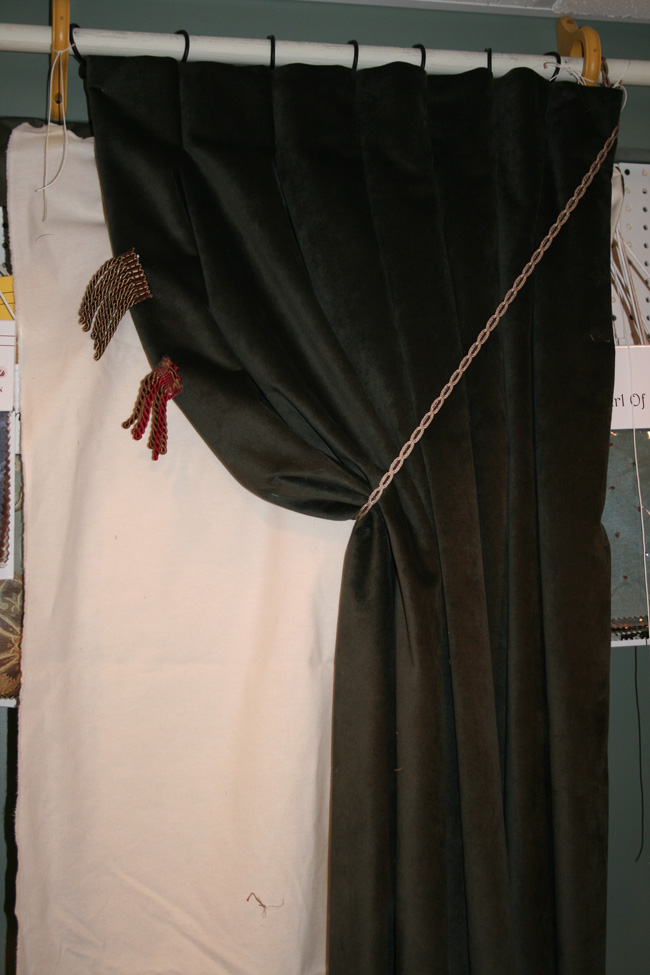(FDR was an avid football fan, and FDR Suite-mate Lathrop Brown managed the Varsity Team in 1903, so to celebrate the big Game this Saturday, I thought it fit to do a little digging into the history of the contest. I was pleasantly pleased to find an extended article by Morton Henry Prince, Class of 1875, in something called The H Book of Harvard Athletics, printed in 1923, and donated to the Restoration by the descendants of Chester Robinson ’04. Prince who served as secretary to the first Harvard Football Club and who witnessed events first hand, relates how Harvard’s unwillingness to change its traditional ways led directly to rise of football as we know it.
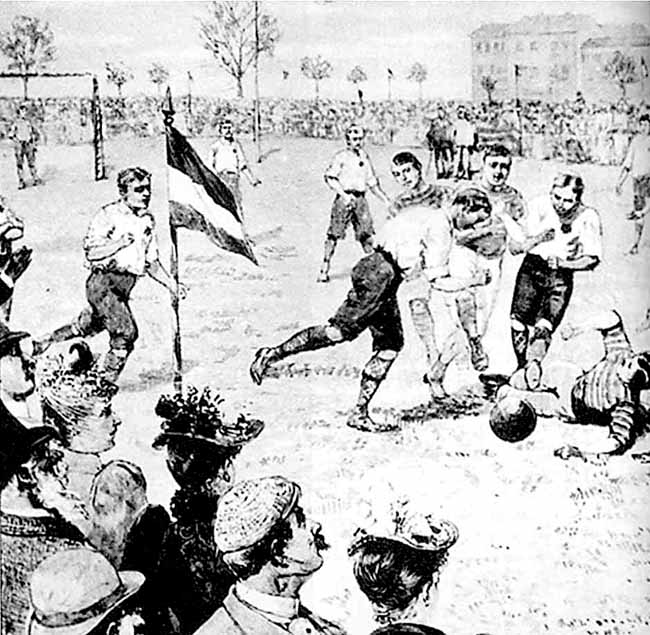
An early football game, along the lines of that played at Harvard in the 1860s & 70s. Note the round ball, and complete lack of uniforms or equipment!
By Morton (Henry) Prince ’75
To understand the history of football at Harvard, it is necessary to realize that during the 1850s and 1860s, the College played a game that had been played for many years in the preparatory schools of Massachusetts, particularly those of Boston. The rules were simple and through tradition were well established. Theoretically, any number could play on a side, but practically only ten or fifteen played because not more than twenty or thirty turned out each afternoon for a game. Instead of goal posts, the goal, over which the football had to be kicked on the fly, was only an imaginary line across the whole width of the field at the end. But after the game had become well established in College and match games were introduced a rope was strung across on supports about five feet above the ground.
The players were assigned to positions of “tenders,” “half-tends” (referring to the goal and corresponding to the present “full backs” and “half backs,”) and “rushers.”
The ball was round, and made of a non-elastic rubber fabric material similar to that of which rubber boots are made. The rubber only made it airtight. Kicking was the predominant feature of the game, but under a certain condition a player was allowed to run with the ball, “baby” (dribble) it, or throw it or pass it to another, and these tactics were liberally used. A player holding or running with the ball could be tackled. On the other hand, striking, hacking, tripping and other rough play was forbidden. Of course the ball could be caught or picked up.
The condition which permitted the player to run with, “baby,” throw, and pass the ball was that he be pursued by an adversary. If he ran with the ball he was obliged to stop the moment his opponent ceased the chase, and kick the ball. It may seem curious that this rule worked, but it did. The reason is that the pursuer always called out when he stopped chasing and if the runner did not at once also stop, the cry was taken up by the whole pack of opponents. He was then obliged by tradition to go back to where he was at the crucial moment, before kicking. It is obvious that under this rule there would develop the tactics of a player of the same team running by the side of the player with the ball, who, when tackled, passed the ball to his running mate, who in turn could run if chased, otherwise he must kick or throw the ball. The style of play as developed under these rules and by tradition was remarkably open, and remarkably individual, leaving nearly everything to the skill, initiative and agility of each player….
When winter came the success of the three seasons (two autumns and one spring, 1871) of sport had been so exhilarating that the football enthusiasts felt that the game ought to have wider support and that all the students ought to be invited and encourage to join and learn to play. Accordingly, a mass meeting was called in Holden Chapel, and the Harvard University Football Club was formed on 3 December 1872, and the set of rules that were adopted were essentially those as handed down by tradition…
In October of 1873 a letter was received by the caption of our team from Yale inviting us to send delegates to a convention, to be held in New York, of the five colleges which had shown the most interest in football, namely Harvard, Columbia, Rutgers, Princeton and Yale. The purpose of the call was to form an Intercollegiate Association and agree upon a code of rules. However, there was an essential problem: one fundamental principle of our game, determining the whole character of the play, was, I may repeat, that a player was permitted to pick up the ball, run with it, throw it, or pass it. He could also seize and hold an adversary to prevent his getting the ball. Quite contrary to this were the Yale rules, which were essentially the same as those of Princeton, Columbia, and Rutgers: no picking up, carrying or throwing the ball was allowed, nor was holding or pushing with the hands. The game was all footwork. The styles of game were consequently vitally different, as different as Soccer football is from the present game.
Regretfully, our Captain was instructed to decline Yale’s invitation.
Of course our action drew down upon Harvard considerable adverse criticism, as it was interpreted by Yale as an aloofness at meeting the other colleges in sport. Yet Harvard persevered: “ We must either sacrifice entirely the principle of our game and learn a new one, or abandon all thought of intercollegiate matches. We have chosen the latter alternative.” And with this, the incident was closed, but only for the time being, for the introduction of the Rugby game in the following spring in order to play McGill gave an entirely new aspect to the intercollegiate question and was destined to put American football upon an entirely different basis. But this became possible because of Harvard’s refusal to join the Intercollegiate Association and play the “Association Rules.” If Harvard had not refused it is highly improbably that the modern game played today – the American Rugby – would ever have been evolved. Instead, all universities colleges and schools today would be playing the Association Rules – practically soccer. But as it happened the ancient rivalry between Harvard and Yale with the irresistible desire to play each other finally induced a compromise and acceptance by the two colleges of the Rugby rules with which, as we shall see, Harvard at that epoch had become fortuitously experienced, and for which she had even learned to a acquire a secret taste….

The Momentous Beginning – Harvard at McGill 1874
The Harvard season of 1874, which began in the spring, was destined to be historic for American football because in it occurred the Harvard-McGill game, the first game of intercollegiate Rugby played in this country and the contest which lead directly to the present intercollegiate game. This contest, therefore, and the circumstances attending its inception and the historic event itself deserve to be more fully recorded.
Harvard was surprised and pleased to receive from McGill University in Montreal a proposal for a series of matches. As McGill played under the Rugby rules (slightly modified) it was proposed, in order to overcome the difficulty, that two matches be played, one under the Rugby rules and one under the Harvard rules. Of course we eagerly fell in with the idea of the two matches…
We at once set to work studying the principles of the Rugby game, practicing plays, and working out what could be done under the rules and particularly what tactics under the Harvard rules could be adapted. This gave us, as it turned out, some advantage, for with Yankee shrewdness we discovered that certain of our own plays could be introduced which, though we had not suspected it, had not been thought of by McGill. When in the match we used these plays, the visitors were dumbfounded, and for the moment questioned their propriety, but at once recognized their legality when it was pointed out by the umpire.
In the Magenta [now the Crimson] for May 8, 1874, appeared this notice:
“The McGill University Foot-ball Club will meet the Harvard Club on Jarvis Field, Wednesday and Thursday, the 13th and 14th at 3 o’clock. Admission 50 cents.”
It’s worth noting that the fifty cents admission was charged for an entertainment fund. There was no athletic fund in those days. We had – noblesse oblige – to entertain our visitors and make their visit enjoyable and one to be remembered. How strange that must sound to modern ears. Think of entertaining Yale, or Princeton, or Cornell! Yet not a bad idea!…
At last the great day for football arrived.
In those days of early football the Harvard team was not outfitted with uniforms. No one in the memory of man had ever donned a uniform for football in any college. So we always wore our oldest clothes, which consisted of a pair of trousers and any old shirt. But on this occasion we did a bit better to present a respectable appearance and exhibit a semblance of a uniform. Each member of the eleven donned dark trousers, a white undershirt (which some thought had the advantage of ripping when seized) and a magenta handkerchief tied in a traditional fashion upon the head as was customary with the crews. And thus appareled, to our later mortification (we thought it fine at the moment) the Harvard eleven appeared on the field. In the first match under the Harvard rules, which was not a rough game, the clothing stood the wear and tear, but in the Rugby game it was soon reduced to shreds and patches. When the McGill eleven appeared on the field neatly uniformed after the English fashion, the contrast was remarked upon to our discomfiture.
A crowd of about 500 spectators, mostly students, lined the sides of Jarvis field. All were keyed with intense interest. It needed, however, but a few moments of play to relieve whatever anxiety there was and for it to become obvious that our easy going Canadian visitors had not taken the trouble to practice the game and were totally unfamiliar with it. The match (three games) was speedily over. Harvard won all three.
The second match on the next day was a different affair. We now had to meet our opponents at their own game. Instead of the round “rubber” fabric ball used in the Harvard game, the ball was the English oval, leather-covered ball, substantially the same as that used today in the present American game. The match was hard fought and evenly contested for it turned out to be a drawn battle, neither side scoring a goal or a touchdown in the three half-hours. The fact that we held the McGill team to a draw at their own game speaks well for the skill and general excellence of our men at football, considering that they had only a few weeks in which to study and practice the game. With the matches over, we did not feel that our obligations had ended. There were those of hospitality and sportsmanship. During the two-days stay of our visitors, all the Harvard clubs opened their doors to them; we took them to ourselves and did all that we could to give them a good time and make them feel the spirit of good-fellowship. And, indeed, we found them a set of as good fellows and sportsmen as ever punted a football. We had taken in several hundred dollars in admissions to the matches – quite a tidy little sum in those days – and with this, not being responsible to any auditing committee, I as autocrat of the Treasury am thankful to remember, we blew them off a banquet at Parker’s in Boston, and saw to it that the champagne flowed as it will never do again.
Editors Note: Now that’s my kind of post-game party! Harvard meet McGill again the next season in Montreal, and was once more victorious. Harvard’s Canadian hosts, gracious throughout, outdid even the hospitality shown by the College the previous year in Cambridge, so much so that many of the team members elected to stay a few additional days in Montreal. The McGill-Harvard matches were a watershed, and had the result “of creating at Harvard an interest in and a positive liking for the Rugby game,” according to Prince. Based on this experience, Harvard shortly thereafter suggested to Yale that a compromise might be reached in both schools giving up their particular games for a modified set of Rugby rules, and thus the first Harvard-Yale contest was played in 1875, initiating the sport now called American football.
On a personal note: Thanks to all of our new friends, several hundred strong, who made it back to Adams today for the Harvard Yale celebration, and toured the Suite. We’re so grateful for your show of support! And, congrats to our victorious team, who made this happy day possible. Go Harvard Football!
The FDR Suite Restoration Project at Adams House, Harvard College is funded entirely through your contributions to the FDR Suite Foundation Inc, a public 501(c)3 charity set up to create the only living memorial to FDR at Harvard, as well as a museum of 19th century Harvard student life. We do not receive funds from the University to support this endeavor, and we need your help!

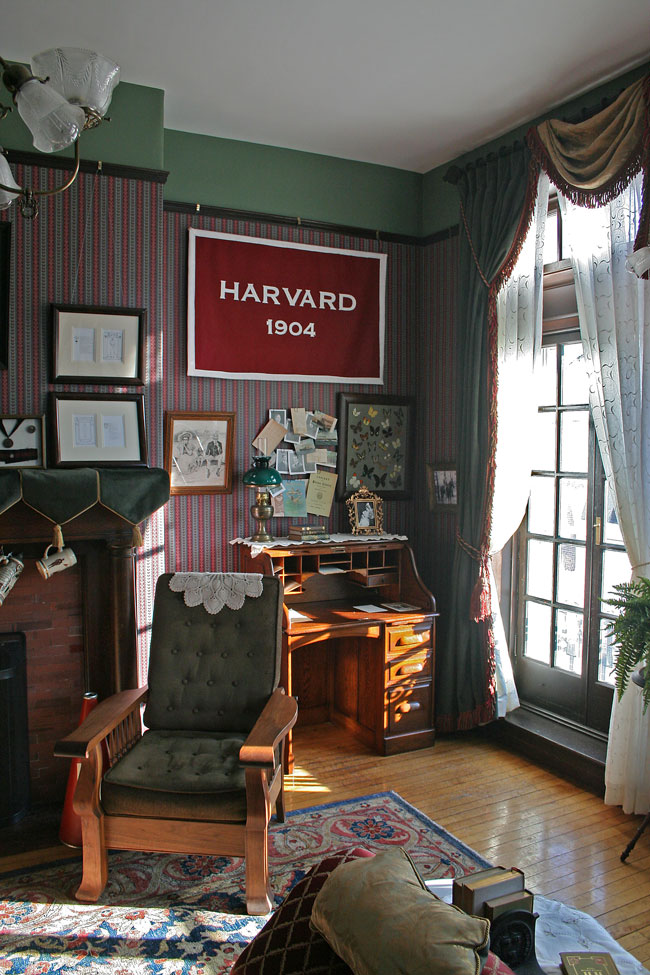




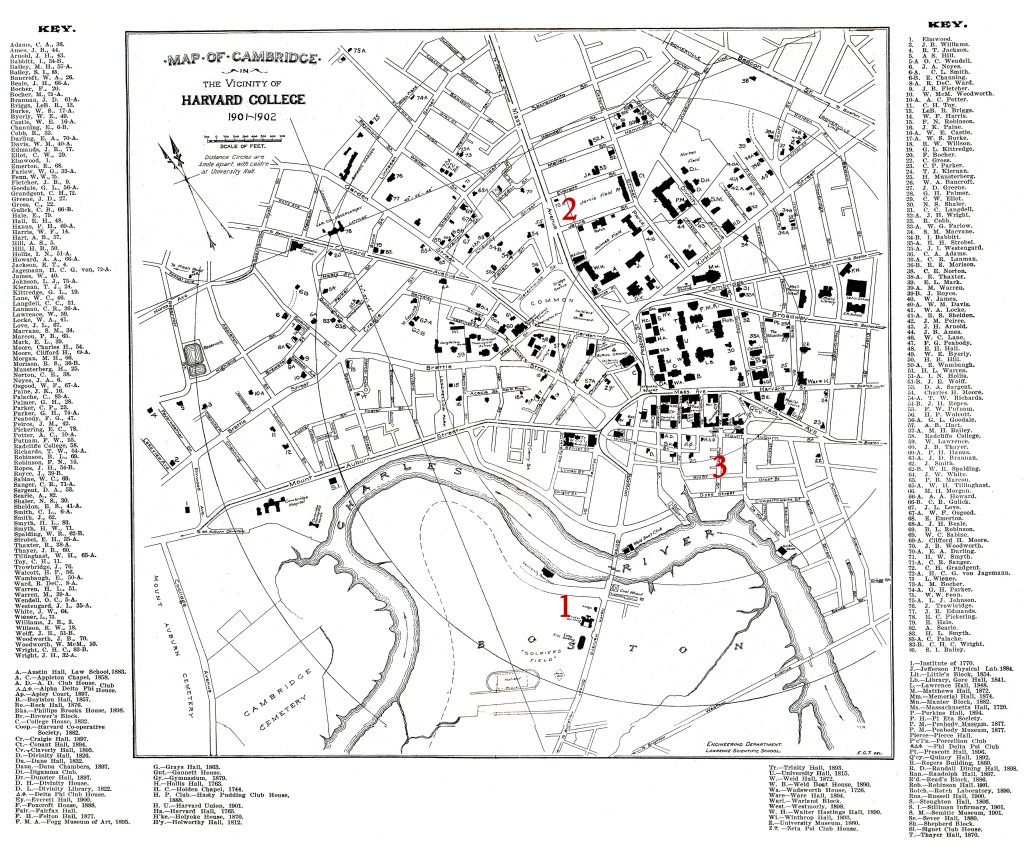


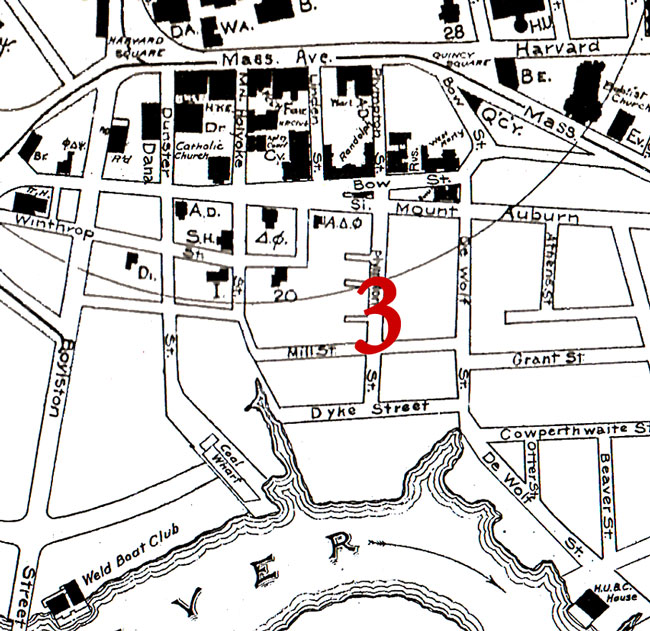
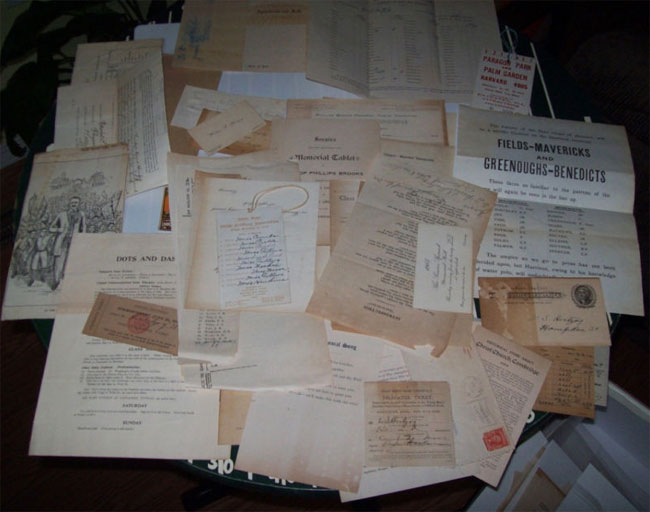
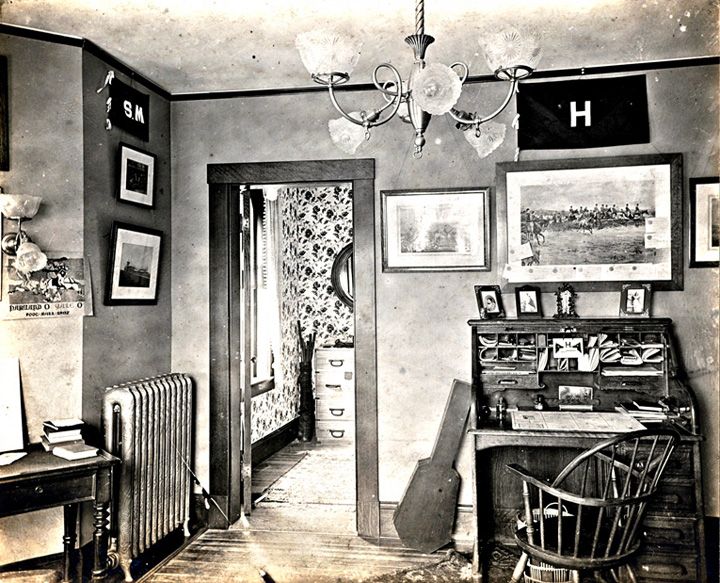

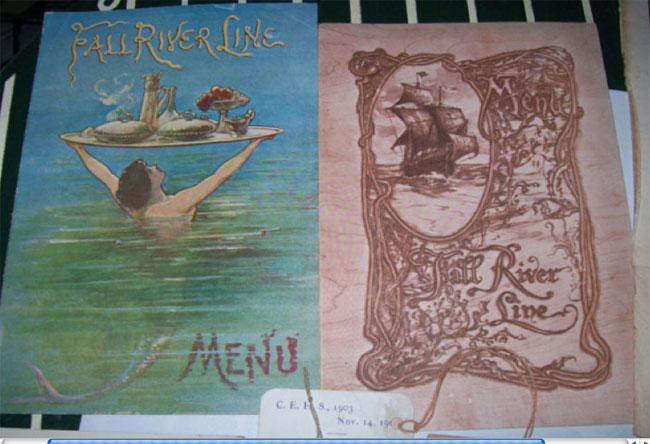
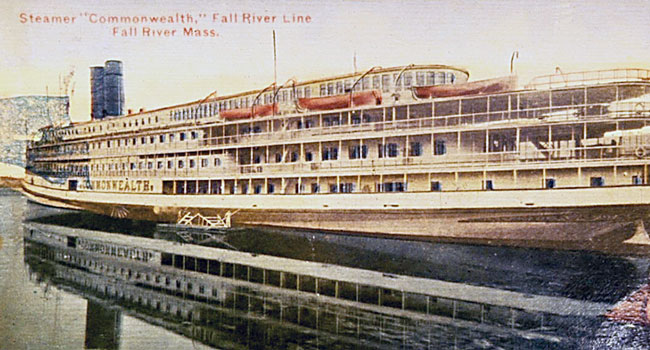
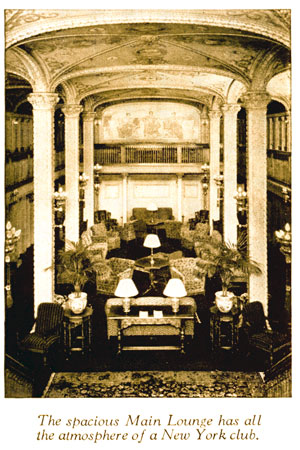 Now this was no run-of-the-mill boat: first class passengers had their own cabins for the eight hour voyage, and the public spaces, as you can see from the picture to the left, were highly luxurious, featuring a library, smoking room, and a dining room that served a full dinner service, hence the menus we found on EBay.
Now this was no run-of-the-mill boat: first class passengers had their own cabins for the eight hour voyage, and the public spaces, as you can see from the picture to the left, were highly luxurious, featuring a library, smoking room, and a dining room that served a full dinner service, hence the menus we found on EBay. l
l m
m -g
-g n
n d
d
